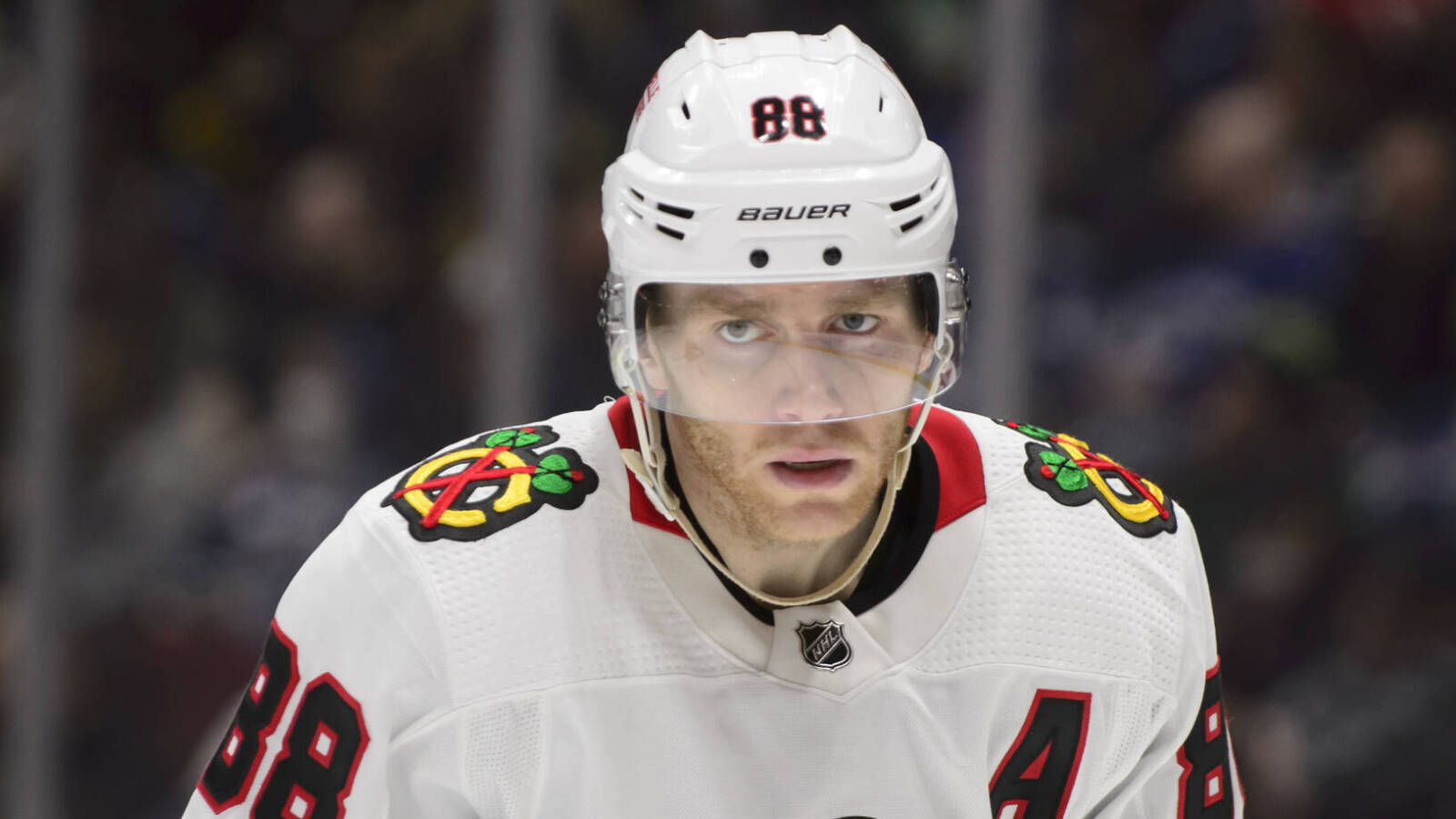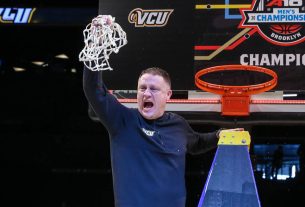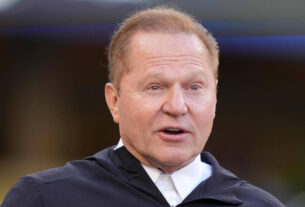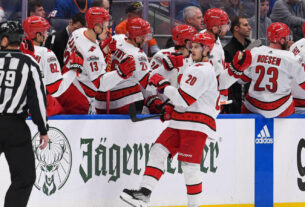Trade? No. It’s more than that. Any deal involving Chicago Blackhawks legend Patrick Kane between now and the March 3 trade deadline will be more like a giant onion, wrapped in layers of drama.
First off: there’s the notion of Kane, a pending UFA, holding all the power in any talks between the Blackhawks and a potential suitor. With his full no-movement clause, he has the final say not just on where he goes, but on whether he goes, just like Claude Giroux did a year ago before letting the Philadelphia Flyers trade him to the Florida Panthers. Kane could still choose to remain in Chicago.
Secondly: Kane’s nagging hip injury has already impacted the suitor list, causing the New York Rangers to hesitate before they pulled the trigger on Vladimir Tarasenko instead, leaving Kane publicly miffed in the process. The hip isn’t keeping Kane, 34, out of Chicago’s lineup often, but it certainly appears to be affecting him. His 0.73 points per game is easily the lowest mark of his future Hall of Fame career, and he’s scored just nine times in 48 games.
Thirdly: Even if the Blackhawks retain 50 percent of the salary on a Kane deal, that only knocks his cap hit down to $5.25 million. In the current cap climate, which is so tight that teams almost thank the heavens for injuries allowing them to use LTIR space, a third-party broker might have to step in to facilitate a deal.
Which teams still have strong enough hockey fits to have interest in Kane despite the injury concern – and presumably could make the money work, broker or not?
Consider these six destinations for the 16-year, 1,155-game veteran, presented alphabetically. In his profile on Kane for DFO, our Frank Seravalli used the Giroux return (first-round pick, third-round pick, Owen Tippett) as a baseline for comparison. We’ll do the same but keep in mind that the injury concern could shave the price a bit (maybe it’s just the first-rounder and a prospect and no additional picks, for instance).
Carolina Hurricanes
Why he makes sense: It’s no secret the Canes are big-game hunting for a scoring-line forward, and the need to do so has increased with two divisional rivals, the New York Islanders and New York Rangers, snapping up a pair of the top available forwards in Bo Horvat and Tarasenko. On pace for their best regular season in franchise history, the Canes and GM Don Waddell might swing bigger for Timo Meier, but if they miss out, Kane could work as a rental fallback. The Canes have the league’s 12th-ranked offense and 22nd-ranked power play. Kane could help there and, perhaps more importantly, brings three Stanley Cup rings and a Conn Smythe Trophy as one of the best clutch players ever. Jordan Staal and Teuvo Teravainen are the only current Canes players with Cup rings.
What it might cost: The Canes could dangle a first-round pick in this year’s or next year’s draft and kick in a prospect below their top tier, such as Jack Drury.
Fly in the ointment: As I wrote in the Meier destinations piece, the Canes arguably need a No. 2 center more than they need a winger, so Kane might be somewhat of a luxury.
Dallas Stars
Why he makes sense: The Stars and GM Jim Nill have been open about their need for a scoring-line forward all season. Their top line of Jason Robertson, Roope Hintz and Joe Pavelski is dynamite, but they otherwise have relied on a combination of forwards who are past their primes (Jamie Benn, Tyler Seguin) or just breaking into the NHL (Wyatt Johnston, Ty Dellandrea, etc.). With Mason Marchment failing to match his incredible production from last season in Florida, the Stars could use one more reliable contributor for their top nine. Sine Pavelski doubles as a center, Dallas could even deepen itself by placing Kane on line 1 and having Pavelski drive his own line.
What it might cost: The Stars gave the Rangers a conditional first-round pick in the Nils Lundkvist trade. The pick was top-10 protected, so the condition will not trigger, meaning Dallas loses its first-rounder for this season. It can still dangle next year’s first-rounder, however, and Dallas’ prospect pool has quietly become pretty exciting. I can’t imagine them being willing to trade a Logan Stankoven, Mavrik Bourque or Thomas Harley in a rental trade for a 34-year-old Kane, but would they move someone in the next tier down like Christian Kyrou?
Fly in the ointment: There are a few. For one: despite the stated need for forward help, Dallas is 11th in goals per game and has the No. 9 power play. The Stars aren’t desperate for scoring, and Kane has become a borderline liability on the defensive side of the puck. Would the cons outweigh the pros? Dallas could also have a tough time fitting the $5.25 million in cap space. If a third party (who would receive some kind of compensation) factors into the acquisition cost, does it scare Nill away?
Edmonton Oilers
Why he makes sense: The high-octane Oiler offense leads the league in goals, powered by the generationally great duo of Connor McDavid and Leon Draisaitl. And yet, the Oilers still repeatedly struggle to fill out the right wing in their top nine, with Kailer Yamamoto and Jesse Puljujarvi taking turns being disappointments. Whether Kane would pair with McDavid or Drasaitl, he’d finally give Edmonton the missing piece in its forward group. With McDavid and Draisaitl’s peak years so precious, the time to win is now. Like, right this second. Kane could replace the Cup-champion voice that his old teammate Duncan Keith brought to the Oilers’ room last year.
What it might cost: The Oilers could sell Pujujarvi as part of a reclamation project package, and his $3 million cap hit could help balance the ledger and make it possible to take on half of Kane’s AAV. But the Oilers might be forced to waive Puljujarvi this week. It will depend on exactly when the injured Yamamoto rejoins the Oiler lineup. Regardless, the Puljujarvi element wouldn’t be the centerpiece of an offer for Kane. The Oilers would likely have to kick in a first-round pick and perhaps a secondary prospect in the Raphael Lavoie range.
Fly in the ointment: Getting a strong shutdown presence on defense has to be the No. 1 priority, right? After all, this is already the top-scoring team in the NHL. Given the cap gymnastics required for the Oilers to do anything right now, it might be tough to get help on defense and still pursue Kane. Unless GM Ken Holland tried to one-stop-shop and get Jake McCabe too? The Hawks have no retained contracts right now and can retain salary on up to three at a time.
Los Angeles Kings
Why he makes sense: The Kings are ready to be alpha dogs again in the Pacific Division. After patiently building up their farm system, they flicked a switch starting in the summer of 2021 and added Phillip Danault, Viktor Arvidsson, Alexander Edler and Kevin Fiala over consecutive offseasons. The Fiala trade in particular symbolized a shift to buyer mode, as the Kings sacrificed prospect Brock Faber and their 2022 first-round pick to make it happen. L.A.’s offense has improved with Fiala in town but still doesn’t penetrate the upper crust of explosive teams. Kane would help a forward group that has been decimated by injuries this season – and a dressing room with him, Anze Kopitar, Drew Doughty and Jonathan Quick would ooze championship experience. Also, from a clause-waiving perspective: Kane’s agent Pat Brisson is L.A. based, so there might be a degree of comfort landing in Tinseltown.
What it might cost: Whatever the cost is, it wouldn’t be a problem for the Kings, whose farm system is impressive and deep. They could put together an enticing package for Kane involving, for instance, a Helge Grans or Alex Turcotte and not have to worry about involving someone like Brandt Clarke or Quinton Byfield.
Fly in the ointment: The Kings, as I write these words, are in hot pursuit of Arizona Coyotes defenseman Jakob Chychrun. The blueline seems to be a higher priority for the Kings. They also might empty the farm system to get Chychrun. Would that make GM Rob Blake less likely to make a second splashy trade?
Toronto Maple Leafs
Why he makes sense: The Leafs’ forward depth has been a problem this season. Whether he played first line with countryman Auston Matthews or in a sheltered third-line role and on the power play, Kane would fill out the depth chart. Kane’s clutch ability can not be overstated; he has five career playoff overtime goals, including the series winner in the 2010 Stanley Cup Final. He’s exactly the kind of rabbit’s foot who could help Toronto end its first-round playoff losing streak. Geographically, the proximity to his hometown Buffalo might make it appealing to waive his NMC, too.
What it might cost: The Leafs might have to get creative in putting together a package for Kane if we are to believe GM Kyle Dubas’ assertion that they won’t give up their 2023 first-rounder or top prospect Matthew Knies for a rental. If Toronto won’t do that, would it still have the horses to tempt Chicago? What if the Hawks kicked the tires on a buy low for oft-injured Nick Robertson? Even when healthy, he’s had a devil of a time staying out of the press box. If the Leafs aren’t going to play him, why not cash him out while he’s still young enough to have a plausible upside at 21?
Fly in the ointment: The last time the Leafs ponied up for a high-profile rental, it was for Nick Foligno, and the result was disastrous. He was banged up, made a minimal impact across seven regular season games and four playoff games and it cost Toronto a first-round pick. Taking the big swing on Kane would expose a degree of desperation we haven’t seen often from Dubas, who prefers to acquire cost-controlled players. But maybe it’s time to be desperate. Dubas’ contract is set to expire after this season.
Vegas Golden Knights
Why he makes sense: The Golden Knights’ affinity for exciting, shiny star players is well-established at this point. Mark Stone’s $9.5 million cap hit can go on LTIR and he can return for the playoffs. The Golden Knights would then project to be one of the few teams that wouldn’t need a third-party broker to afford Kane. He’d be a logical replacement for Stone alongside Jack Eichel, and Kane would improve Vegas’ forward depth further once/if Stone returned from his back injury for the postseason.
What it might cost: The Golden Knights have ravaged their own farm system already and lack a guaranteed star in their current pipeline. If they don’t want to further deplete their prospect pool by trading, say, a Brendan Brisson, GM Kelly McCrimmon could kick the can down the road with an offer centered primarily on picks. The Golden Knights have their first-rounder in the next three drafts.
Fly in the ointment: Would a trade be worth it for a team that might be incapable of a deep run with Stone missing or returning at less than 100 percent? The Golden Knights might be better off standing pat and accumulating some young assets to build around for a change. Kane, not quite right physically and in decline, could put an elite team over the top, but he can’t take a mediocre team on his back at this stage of his career.



